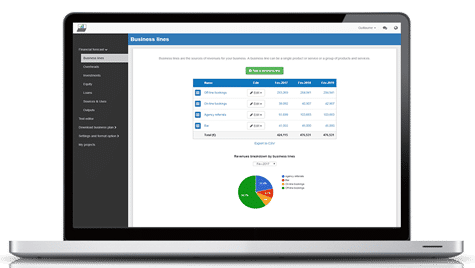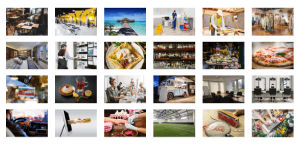How to create a financial forecast for an Italian restaurant?
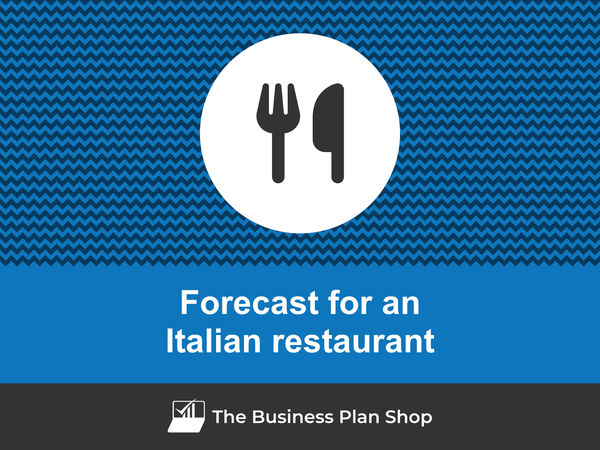
Creating a financial forecast for your Italian restaurant, and ensuring it stays up to date, is the only way to maintain visibility on future cash flows.
This might sound complex, but with the right guidance and tools, creating an accurate financial forecast for your Italian restaurant is not that hard.
In this guide, we'll cover everything from the main goal of a financial projection, the data you need as input, to the tables that compose it, and the tools that can help you build a forecast efficiently.
Without further ado, let us begin!
Why create and maintain a financial forecast for an Italian restaurant?
In order to prosper, your business needs to have visibility on what lies ahead and the right financial resources to grow. This is where having a financial forecast for your Italian restaurant becomes handy.
Creating an Italian restaurant financial forecast forces you to take stock of where your business stands and where you want it to go.
Once you have clarity on the destination, you will need to draw up a plan to get there and assess what it means in terms of future profitability and cash flows for your Italian restaurant.
Having this clear plan in place will give you the confidence needed to move forward with your business’s development.
Having an up-to-date financial forecast for an Italian restaurant is also useful if your trading environment worsens, as the forecast enables you to adjust to your new market conditions and anticipate any potential cash shortfall.
Finally, your Italian restaurant's financial projections will also help you secure financing, as banks and investors alike will want to see accurate projections before agreeing to finance your business.
Need a solid financial forecast?
The Business Plan Shop does the maths for you. Simply enter your revenues, costs and investments. Click save and our online tool builds a three-way forecast for you instantly.
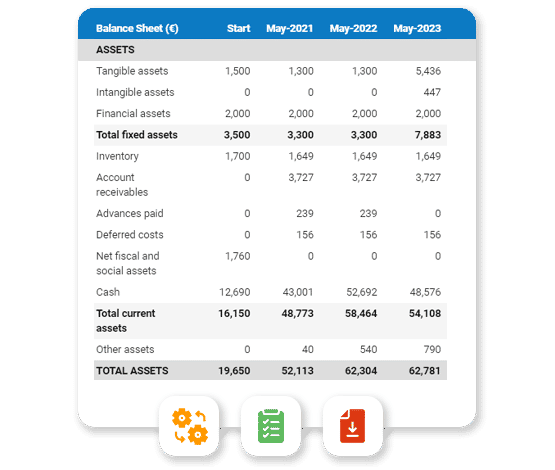
What information is needed to build an Italian restaurant financial forecast?
The quality of your inputs is key when it comes to financial modelling: no matter how good the model is, if your inputs are off, so will the forecast.
If you are building a financial plan to start an Italian restaurant, you will need to have done your market research and have a clear picture of your sales and marketing strategies so that you can project revenues with confidence.
You will also need to have a clear idea of what resources will be required to operate the Italian restaurant on a daily basis, and to have done your research with regard to the equipment needed to launch your venture (see further down this guide).
If you are creating a financial forecast of an existing Italian restaurant, things are usually simpler as you will be able to use your historical accounting data as a budgeting base, and complement that with your team’s view on what lies ahead for the years to come.
Let's now zoom in on what will go in your Italian restaurant's financial forecast.
The sales forecast for an Italian restaurant
From experience, it is usually best to start creating your Italian restaurant financial forecast by your sales forecast.
To create an accurate sales forecast for your Italian restaurant, you will have to rely on the data collected in your market research, or if you're running an existing Italian restaurant, the historical data of the business, to estimate two key variables:
- The average price
- The number of monthly transactions
To get there, you will need to consider the following factors:
- Menu Changes: As the owner, you have the ability to adjust your menu and introduce new dishes. This can impact your average price by offering higher-priced items or increase the number of monthly transactions by attracting new customers with unique dishes.
- Seasonal Ingredients: Seasonal ingredients play a significant role in Italian cuisine. Depending on the time of year, certain ingredients may be more expensive or difficult to source. This can affect your average price as you may need to adjust menu prices or the availability of certain dishes, which can impact the number of monthly transactions.
- Consumer Preferences: As consumer preferences and trends change, so may their expectations for Italian cuisine. This can affect your average price as you may need to adjust your menu to meet these preferences, or it can impact the number of monthly transactions if customers are seeking a different type of Italian food.
- Competition: The presence of other Italian restaurants in the area can affect your average price and number of monthly transactions. If there is high competition, you may need to lower your prices to stay competitive, or offer promotions to attract customers. On the other hand, if you are the only Italian restaurant in the area, you may be able to charge higher prices and see an increase in monthly transactions.
- Events and Holidays: Special events and holidays can have a significant impact on an Italian restaurant's average price and number of monthly transactions. For example, during Valentine's Day or Mother's Day, you may see an increase in customers and higher-priced menu items, while slower times like the winter holidays may see a decrease in both average price and monthly transactions.
Once you have an idea of what your future sales will look like, it will be time to work on your overhead budget. Let’s see what this entails.
Need inspiration for your business plan?
The Business Plan Shop has dozens of business plan templates that you can use to get a clear idea of what a complete business plan looks like.
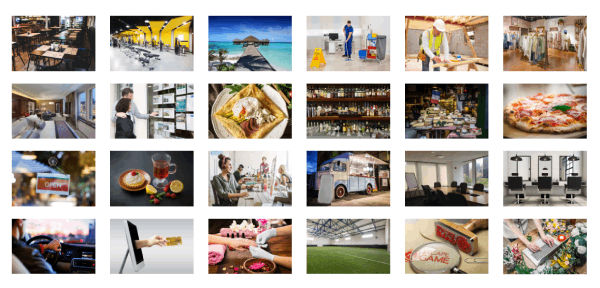
The operating expenses for an Italian restaurant
Once you know what level of sales you can expect, you can start budgeting the expenses required to operate your Italian restaurant on a daily basis.
Expenses normally vary based on how much revenue you anticipate (which is why, from experience, it is always better to start your forecast with the topline projection), and where your business is based.
Operating expenses for an Italian restaurant will include some of the following items:
- Ingredients: This includes the cost of all the food items that you will be using in your dishes, such as pasta, tomatoes, cheese, and meats.
- Staff Costs: Your restaurant will require a team of chefs, waiters, and other staff members to run smoothly. Remember to include their salaries, benefits, and any other related expenses.
- Rent: The cost of renting a space for your restaurant can be a significant expense. Make sure to factor in monthly rent payments, as well as any utilities that you will need to pay.
- Marketing and Advertising: In order to attract customers, you will need to invest in marketing and advertising efforts. This can include creating flyers, running social media ads, and sponsoring local events.
- Accountancy Fees: It is important to keep track of your restaurant's finances, so hiring an accountant or bookkeeper can be a valuable expense.
- Insurance Costs: Protecting your restaurant from potential risks and liabilities is crucial. Consider purchasing insurance for your business, including general liability and property insurance.
- Software Licences: In today's digital age, having the right software can help you streamline your operations and improve efficiency. This can include point-of-sale systems, inventory management software, and employee scheduling programs.
- Banking Fees: Your restaurant will have various financial transactions, such as credit card payments and cash deposits, which may incur banking fees. Make sure to factor in these costs when creating your budget.
- Waste Disposal: Properly disposing of food waste and other materials is not only important for the environment but also for maintaining a clean and hygienic restaurant. Consider the cost of waste disposal services in your operating expenses forecast.
- Repairs and Maintenance: As with any business, there will be regular wear and tear on your restaurant's equipment and facilities. Budget for repairs and maintenance costs to keep your restaurant running smoothly.
- Training and Development: Keeping your staff well-trained and up-to-date on industry trends and techniques is important for the success of your restaurant. Consider investing in training programs and workshops for your team.
- Cleaning Supplies: A clean and sanitary restaurant is essential for maintaining a good reputation. Include the cost of cleaning supplies, such as detergents, paper towels, and trash bags, in your operating expenses forecast.
- Licences and Permits: In order to operate your restaurant legally, you will need to obtain various licences and permits. This can include a food service permit, liquor license, and health department permits.
- Utilities: Your restaurant will have ongoing expenses for electricity, gas, and water. Make sure to account for these costs in your operating expenses forecast.
- Credit Card Processing Fees: If your restaurant accepts credit or debit card payments, you will need to pay processing fees for each transaction. Consider these costs when creating your budget.
This list will need to be tailored to the specificities of your Italian restaurant, but should offer a good starting point for your budget.
What investments are needed to start or grow an Italian restaurant?
Creating and expanding an Italian restaurant also requires investments which you need to factor into your financial forecast.
Capital expenditures and initial working capital items for an Italian restaurant could include elements such as:
- Commercial Kitchen Equipment: This includes items such as ovens, stovetops, refrigerators, and other appliances necessary for preparing and storing food in an Italian restaurant.
- Furniture and Fixtures: Tables, chairs, and other furniture pieces in the dining area, as well as lighting fixtures and decor elements, are important capital expenditures for creating a welcoming and authentic Italian atmosphere.
- Point of Sale (POS) System: A reliable POS system is necessary for processing orders, tracking sales, and managing inventory in an Italian restaurant. This may include hardware such as cash registers and credit card machines, as well as software for managing orders and payments.
- Wine and Bar Equipment: For Italian restaurants that offer a selection of wine and cocktails, investing in quality bar equipment such as glasses, shakers, and wine chillers is essential for providing a premium dining experience.
- Building Renovations: If you are starting an Italian restaurant in a new location, you may need to make renovations to the building to meet your specific needs and create a comfortable and functional space for customers.
Again, this list is not exhaustive and will need to be adjusted according to the circumstances of your Italian restaurant.
Need a convincing business plan?
The Business Plan Shop makes it easy to create a financial forecast to assess the potential profitability of your projects, and write a business plan that’ll wow investors.
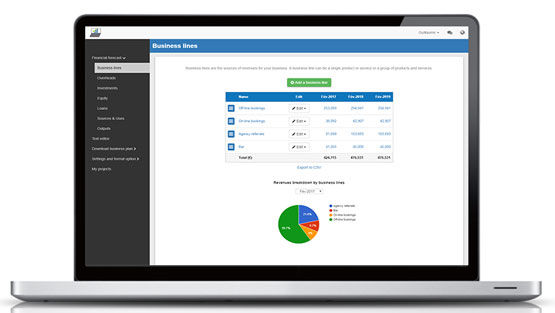
The financing plan of your Italian restaurant
The next step in the creation of your financial forecast for your Italian restaurant is to think about how you might finance your business.
You will have to assess how much capital will come from shareholders (equity) and how much can be secured through banks.
Bank loans will have to be modelled so that you can separate the interest expenses from the repayments of principal, and include all this data in your forecast.
Issuing share capital and obtaining a bank loan are two of the most common ways that entrepreneurs finance their businesses.
What tables compose the financial plan for an Italian restaurant?
Now let's have a look at the main output tables of your Italian restaurant's financial forecast.
The projected profit & loss statement
The projected profit & loss shows how profitable your Italian restaurant is likely to be in the years to come.
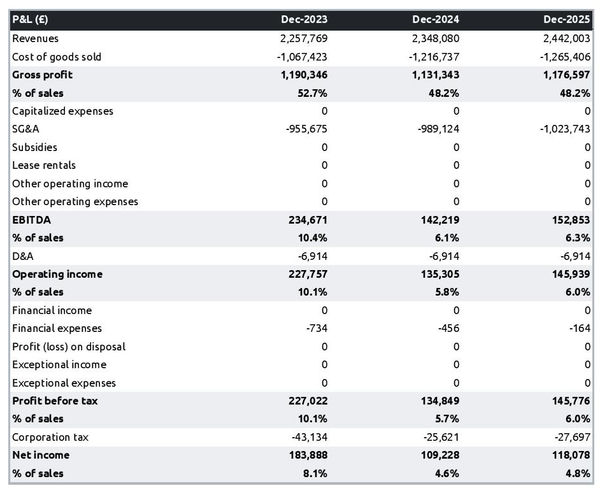
For your Italian restaurant to be financially viable, your projected P&L should ideally show:
- Sales growing above inflation (the higher the better)
- Profit margins which are stable or expanding (the higher the better)
- A net profit at the end of each financial year (the higher the better)
This is for established Italian restaurants, there is some leniency for startups which will have numbers that will look a bit different than existing businesses.
The projected balance sheet
Your Italian restaurant's projected balance sheet provides a snapshot of your business’s financial position at year-end.
It is composed of three types of elements: assets, liabilities and equity:
- Assets: represent what the business possesses including cash, equipment, and accounts receivable (money owed by clients).
- Liabilities: represent funds advanced to the business by lenders and other creditors. They include accounts payable (money owed to suppliers), taxes payable and loans from banks and financial institutions.
- Equity: is the combination of what has been invested by the business owners and the cumulative profits and losses generated by the business to date (which are called retained earnings). Equity is a proxy for the value of the owner's stake in the business.
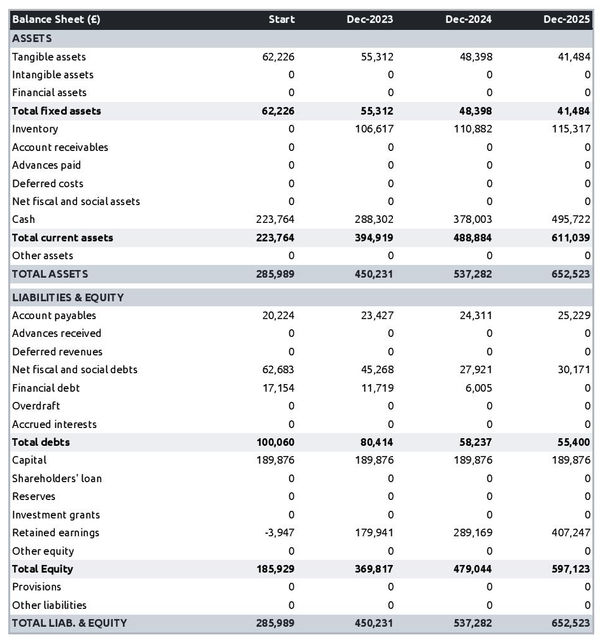
The cash flow projection
The cash flow forecast of your Italian restaurant will show how much cash the business is expected to generate or consume over the next three to five years.
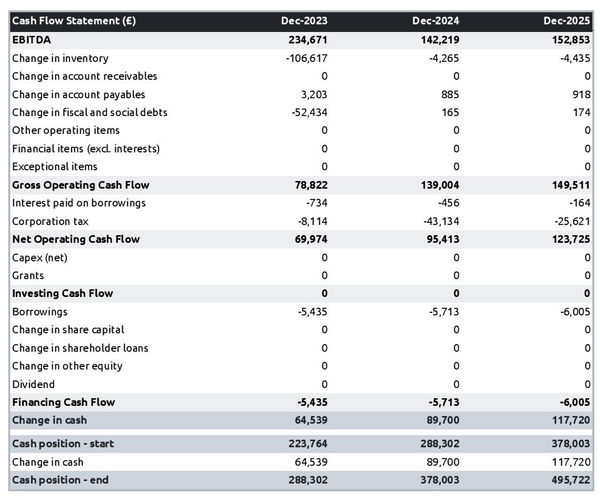
There are multiple ways of presenting a cash flow forecast but from experience, it is better to organise it by nature in order to clearly show these elements:
- Operating cash flow: how much cash is generated by the Italian restaurant's operations
- Investing cash flow: what is the business investing to expand or maintain its equipment
- Financing cash flow: is the business raising additional funds or repaying financiers (debt repayment, dividends)
Your cash flow forecast is the most important element of your overall financial projection and that’s where you should focus your attention to ensure that your Italian restaurant is adequately funded.
Note: if you are preparing a financial forecast in order to try to secure funding, you will need to include both a yearly and monthly cash flow forecast in your Italian restaurant's financial plan.
Need a solid financial forecast?
The Business Plan Shop does the maths for you. Simply enter your revenues, costs and investments. Click save and our online tool builds a three-way forecast for you instantly.

Which tool should you use to create your Italian restaurant's financial forecast?
Creating your Italian restaurant's financial forecast may sound fairly daunting, but the good news is that there are several ways to go about it.
Using online financial projection software to build your Italian restaurant's forecast
The modern and easiest way to build a forecast is to use professional financial projection software such as the one we offer at The Business Plan Shop.
There are several advantages to using specialised software:
- You can easily create your financial forecast by letting the software take care of the financial calculations for you without errors
- You have access to complete financial forecast templates
- You get a complete financial forecast ready to be sent to your bank or investors
- You can easily track your actual financial performance against your financial forecast, and recalibrate your forecast as the year goes by
- You can create scenarios to stress test your forecast's main assumptions
- You can easily update your forecast as time goes by to maintain visibility on future cash flows
- You have a friendly support team on standby to assist you when you are stuck
- It’s cost-efficient and much cheaper than using an accountant or consultant (see below)
If you are interested in this type of solution, you can try our forecasting software for free by signing up here.
Calling in a financial consultant or chartered accountant
Outsourcing the creation of your Italian restaurant financial forecast is another possible solution.
This will cost more than using software as you can expect as your price will have to cover the accountant’s time, software cost, and profit margin.
Price can vary greatly based on the complexity of your business. For a small business, from experience, a simple three-year financial forecast (including a balance sheet, income statement, and cash flow statement) will start at around £700 or $1,000.
Bear in mind that this is for forecasts produced at a single point in time, updating or tracking your forecast against actuals will cost extra.
If you decide to outsource your forecasting:
- Make sure the professional has direct experience in your industry and is able to challenge your assumptions constructively.
- Steer away from consultants using sectorial ratios to build their client’s financial forecasts (these projections are worthless for a small business).
Why not use a spreadsheet such as Excel or Google Sheets to build your Italian restaurant's financial forecast?
Creating an accurate and error-free Italian restaurant financial forecast with a spreadsheet is very technical and requires a deep knowledge of accounting and an understanding of financial modelling.
Very few business owners are financially savvy enough to be able to build a forecast themselves on Excel without making mistakes.
Lenders and investors know this, which is why forecasts created on Excel by the business owner are often frowned upon.
Having numbers one can trust is key when it comes to financial forecasting and to that end using software is much safer.
Using financial forecasting software is also faster than using a spreadsheet, and, with the rise of artificial intelligence, software is also becoming smarter at helping us analyse the numbers to make smarter decisions.
Finally, like everything with spreadsheets, tracking actuals vs. forecasts and keeping your projections up to date as the year progresses is manual, tedious, and error-prone. Whereas financial projection software like The Business Plan Shop is built for this.
Need a convincing business plan?
The Business Plan Shop makes it easy to create a financial forecast to assess the potential profitability of your projects, and write a business plan that’ll wow investors.

Use our financial projection templates for inspiration
The Business Plan Shop has dozens of financial forecasting templates available.
Our examples contain both the financial forecast, and a written business plan which presents, in detail, the company, the team, the strategy, and the medium-term objectives.
Whether you are just starting out or already have your own Italian restaurant, looking at our template is always a good way to get ideas on how to model financial items and what to write when creating a business plan to secure funding.

Takeaways
- A financial projection shows expected growth, profitability, and cash generation for your business over the next three to five years.
- Tracking actuals vs. forecast and keeping your financial forecast up-to-date is the only way to maintain visibility on future cash flows.
- Using financial forecasting software makes it easy to create and maintain up-to-date projections for your Italian restaurant.
You have reached the end of our guide. We hope you now have a better understanding of how to create a financial forecast for an Italian restaurant. Don't hesitate to contact our team if you have any questions or want to share your experience building forecasts!
Need inspiration for your business plan?
The Business Plan Shop has dozens of business plan templates that you can use to get a clear idea of what a complete business plan looks like.

Also on The Business Plan Shop
Know someone who runs or wants to start an Italian restaurant? Share our financial projection guide with them!

